Gun Violence in America: Causes, Solutions, and Policy Debates
VerifiedAdded on 2023/05/29
|9
|1479
|306
Essay
AI Summary
This essay provides a comprehensive analysis of gun violence in the United States. It begins by defining gun violence and highlighting its prevalence, supported by statistical data comparing the US to other high-income countries. The essay then delves into the problem, emphasizing the high rates of gun ownership, mass shootings, and gun-related deaths in America. It proposes solutions, including developing a culture of gun safety through stricter gun laws, reducing access to firearms for at-risk individuals, and increasing accountability within the gun industry. The essay acknowledges potential objections to these solutions, primarily the Second Amendment and concerns about self-defense. It offers alternative solutions, such as addressing gun violence as a public health concern, supporting community planning initiatives, and fostering mental health support systems. The essay concludes by reiterating the severity of gun violence in the US and advocating for policies that promote gun safety and address the issue from a mental health perspective, ultimately aiming to reduce gun violence risks. The essay also includes figures and a works cited section.
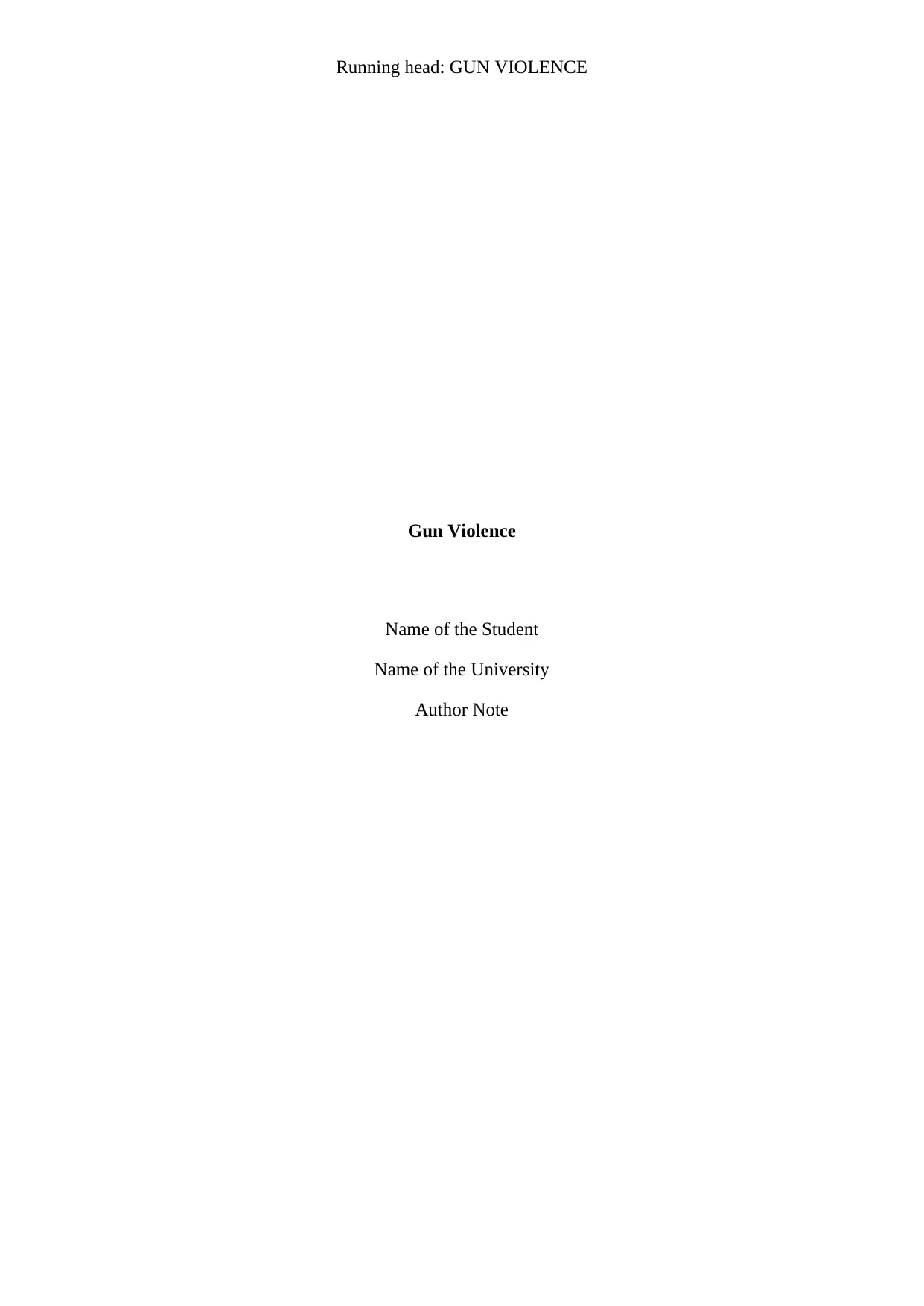
Running head: GUN VIOLENCE
Gun Violence
Name of the Student
Name of the University
Author Note
Gun Violence
Name of the Student
Name of the University
Author Note
Paraphrase This Document
Need a fresh take? Get an instant paraphrase of this document with our AI Paraphraser
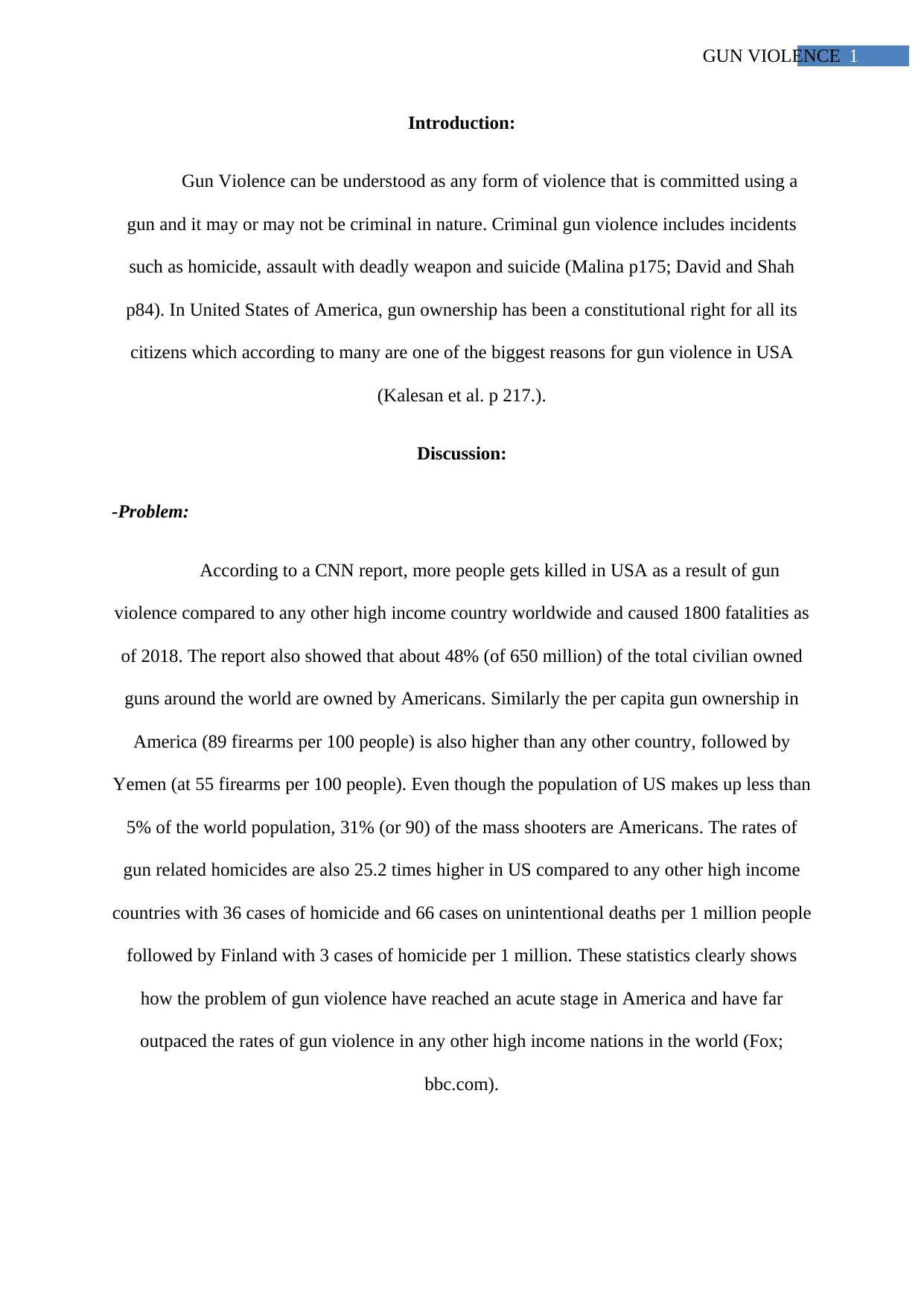
1GUN VIOLENCE
Introduction:
Gun Violence can be understood as any form of violence that is committed using a
gun and it may or may not be criminal in nature. Criminal gun violence includes incidents
such as homicide, assault with deadly weapon and suicide (Malina p175; David and Shah
p84). In United States of America, gun ownership has been a constitutional right for all its
citizens which according to many are one of the biggest reasons for gun violence in USA
(Kalesan et al. p 217.).
Discussion:
-Problem:
According to a CNN report, more people gets killed in USA as a result of gun
violence compared to any other high income country worldwide and caused 1800 fatalities as
of 2018. The report also showed that about 48% (of 650 million) of the total civilian owned
guns around the world are owned by Americans. Similarly the per capita gun ownership in
America (89 firearms per 100 people) is also higher than any other country, followed by
Yemen (at 55 firearms per 100 people). Even though the population of US makes up less than
5% of the world population, 31% (or 90) of the mass shooters are Americans. The rates of
gun related homicides are also 25.2 times higher in US compared to any other high income
countries with 36 cases of homicide and 66 cases on unintentional deaths per 1 million people
followed by Finland with 3 cases of homicide per 1 million. These statistics clearly shows
how the problem of gun violence have reached an acute stage in America and have far
outpaced the rates of gun violence in any other high income nations in the world (Fox;
bbc.com).
Introduction:
Gun Violence can be understood as any form of violence that is committed using a
gun and it may or may not be criminal in nature. Criminal gun violence includes incidents
such as homicide, assault with deadly weapon and suicide (Malina p175; David and Shah
p84). In United States of America, gun ownership has been a constitutional right for all its
citizens which according to many are one of the biggest reasons for gun violence in USA
(Kalesan et al. p 217.).
Discussion:
-Problem:
According to a CNN report, more people gets killed in USA as a result of gun
violence compared to any other high income country worldwide and caused 1800 fatalities as
of 2018. The report also showed that about 48% (of 650 million) of the total civilian owned
guns around the world are owned by Americans. Similarly the per capita gun ownership in
America (89 firearms per 100 people) is also higher than any other country, followed by
Yemen (at 55 firearms per 100 people). Even though the population of US makes up less than
5% of the world population, 31% (or 90) of the mass shooters are Americans. The rates of
gun related homicides are also 25.2 times higher in US compared to any other high income
countries with 36 cases of homicide and 66 cases on unintentional deaths per 1 million people
followed by Finland with 3 cases of homicide per 1 million. These statistics clearly shows
how the problem of gun violence have reached an acute stage in America and have far
outpaced the rates of gun violence in any other high income nations in the world (Fox;
bbc.com).
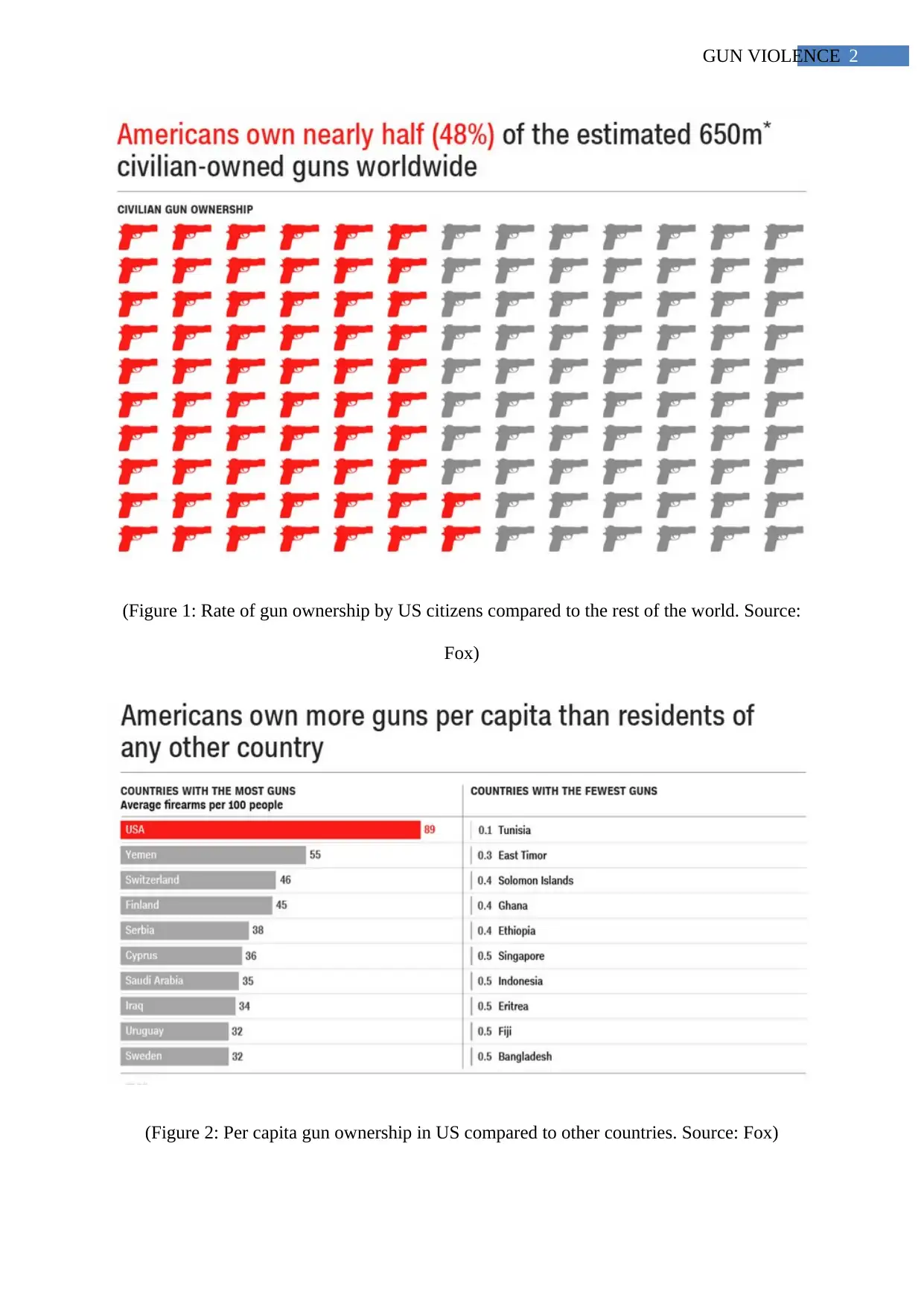
2GUN VIOLENCE
(Figure 1: Rate of gun ownership by US citizens compared to the rest of the world. Source:
Fox)
(Figure 2: Per capita gun ownership in US compared to other countries. Source: Fox)
(Figure 1: Rate of gun ownership by US citizens compared to the rest of the world. Source:
Fox)
(Figure 2: Per capita gun ownership in US compared to other countries. Source: Fox)
⊘ This is a preview!⊘
Do you want full access?
Subscribe today to unlock all pages.

Trusted by 1+ million students worldwide
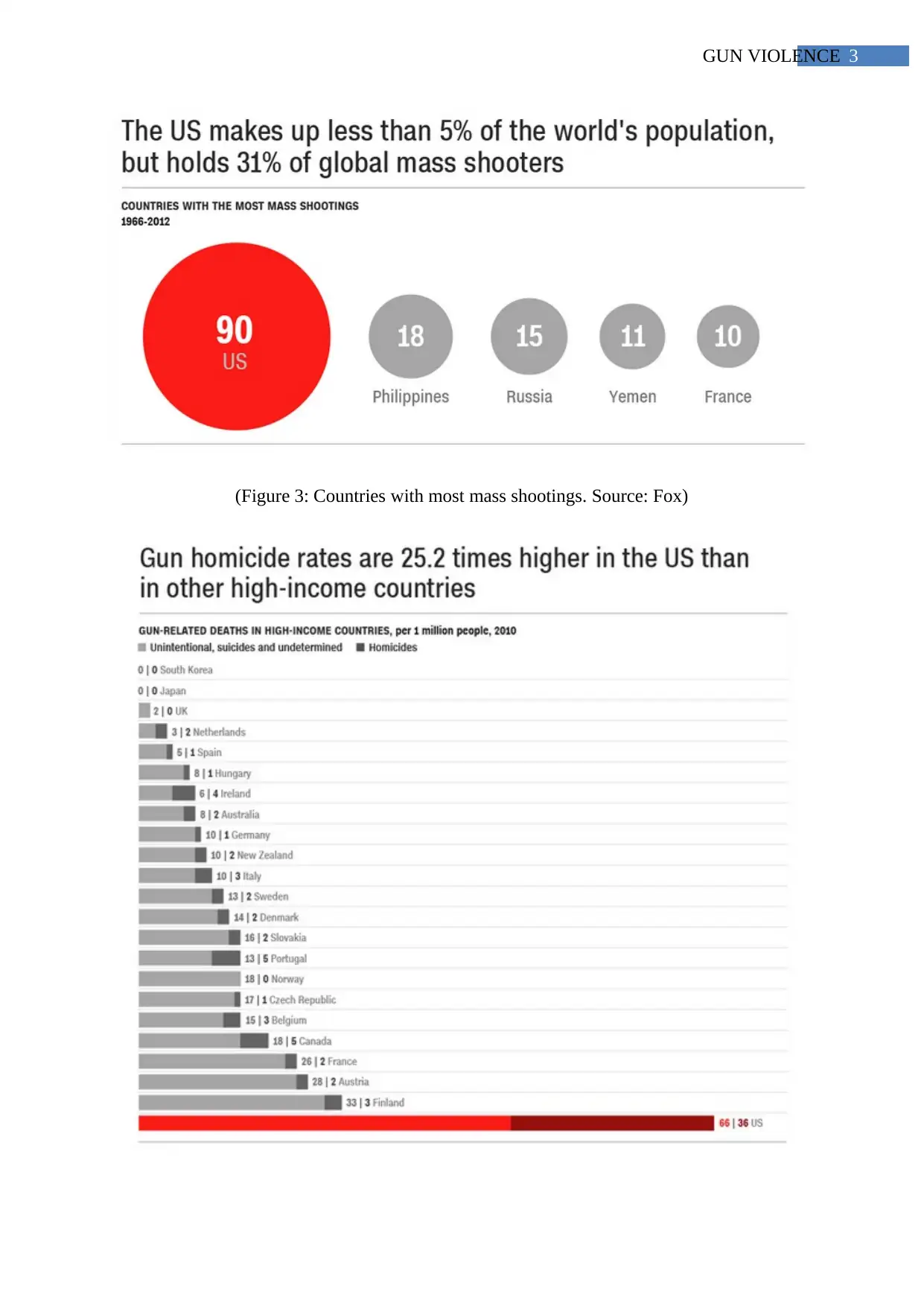
3GUN VIOLENCE
(Figure 3: Countries with most mass shootings. Source: Fox)
(Figure 3: Countries with most mass shootings. Source: Fox)
Paraphrase This Document
Need a fresh take? Get an instant paraphrase of this document with our AI Paraphraser
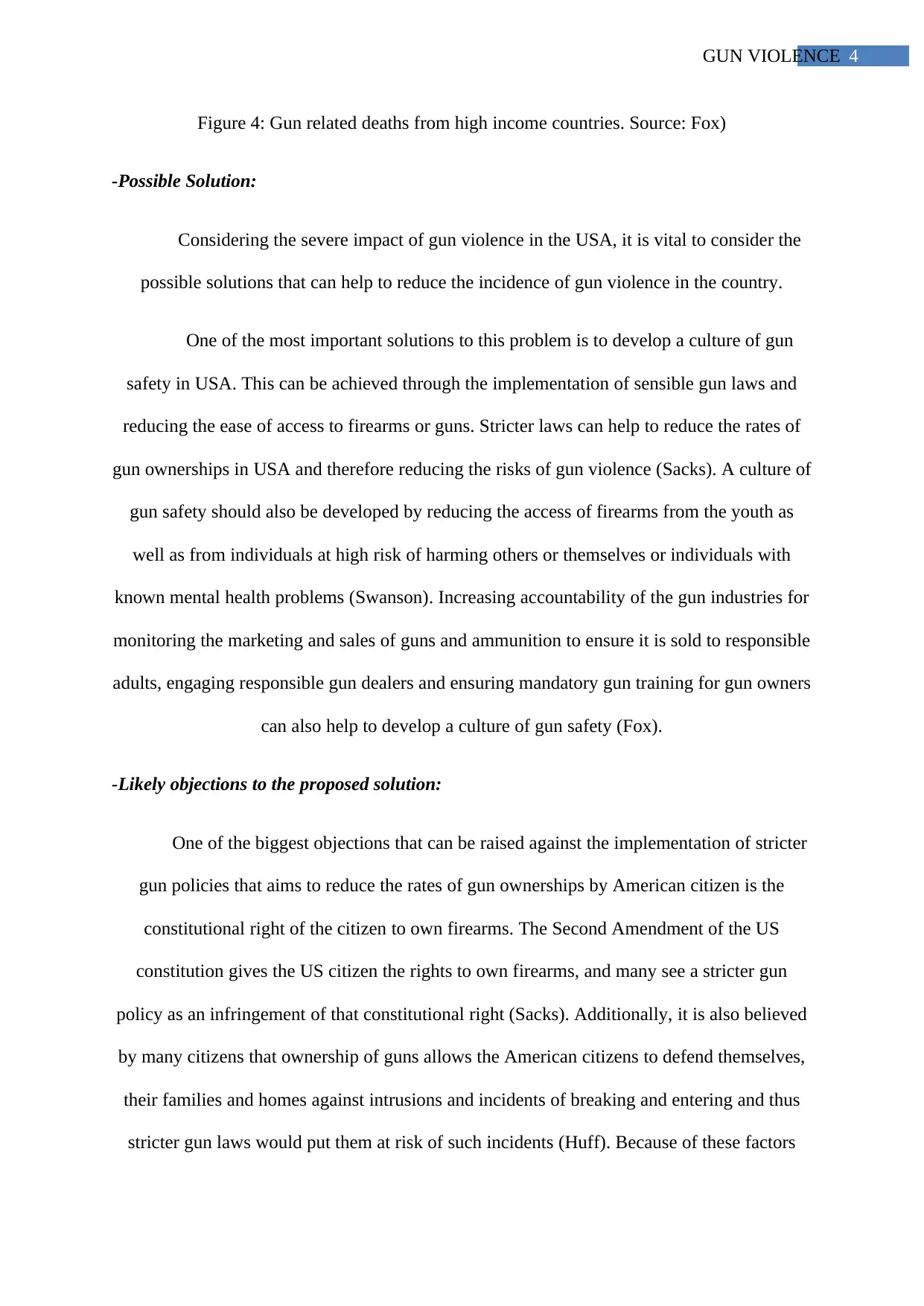
4GUN VIOLENCE
Figure 4: Gun related deaths from high income countries. Source: Fox)
-Possible Solution:
Considering the severe impact of gun violence in the USA, it is vital to consider the
possible solutions that can help to reduce the incidence of gun violence in the country.
One of the most important solutions to this problem is to develop a culture of gun
safety in USA. This can be achieved through the implementation of sensible gun laws and
reducing the ease of access to firearms or guns. Stricter laws can help to reduce the rates of
gun ownerships in USA and therefore reducing the risks of gun violence (Sacks). A culture of
gun safety should also be developed by reducing the access of firearms from the youth as
well as from individuals at high risk of harming others or themselves or individuals with
known mental health problems (Swanson). Increasing accountability of the gun industries for
monitoring the marketing and sales of guns and ammunition to ensure it is sold to responsible
adults, engaging responsible gun dealers and ensuring mandatory gun training for gun owners
can also help to develop a culture of gun safety (Fox).
-Likely objections to the proposed solution:
One of the biggest objections that can be raised against the implementation of stricter
gun policies that aims to reduce the rates of gun ownerships by American citizen is the
constitutional right of the citizen to own firearms. The Second Amendment of the US
constitution gives the US citizen the rights to own firearms, and many see a stricter gun
policy as an infringement of that constitutional right (Sacks). Additionally, it is also believed
by many citizens that ownership of guns allows the American citizens to defend themselves,
their families and homes against intrusions and incidents of breaking and entering and thus
stricter gun laws would put them at risk of such incidents (Huff). Because of these factors
Figure 4: Gun related deaths from high income countries. Source: Fox)
-Possible Solution:
Considering the severe impact of gun violence in the USA, it is vital to consider the
possible solutions that can help to reduce the incidence of gun violence in the country.
One of the most important solutions to this problem is to develop a culture of gun
safety in USA. This can be achieved through the implementation of sensible gun laws and
reducing the ease of access to firearms or guns. Stricter laws can help to reduce the rates of
gun ownerships in USA and therefore reducing the risks of gun violence (Sacks). A culture of
gun safety should also be developed by reducing the access of firearms from the youth as
well as from individuals at high risk of harming others or themselves or individuals with
known mental health problems (Swanson). Increasing accountability of the gun industries for
monitoring the marketing and sales of guns and ammunition to ensure it is sold to responsible
adults, engaging responsible gun dealers and ensuring mandatory gun training for gun owners
can also help to develop a culture of gun safety (Fox).
-Likely objections to the proposed solution:
One of the biggest objections that can be raised against the implementation of stricter
gun policies that aims to reduce the rates of gun ownerships by American citizen is the
constitutional right of the citizen to own firearms. The Second Amendment of the US
constitution gives the US citizen the rights to own firearms, and many see a stricter gun
policy as an infringement of that constitutional right (Sacks). Additionally, it is also believed
by many citizens that ownership of guns allows the American citizens to defend themselves,
their families and homes against intrusions and incidents of breaking and entering and thus
stricter gun laws would put them at risk of such incidents (Huff). Because of these factors
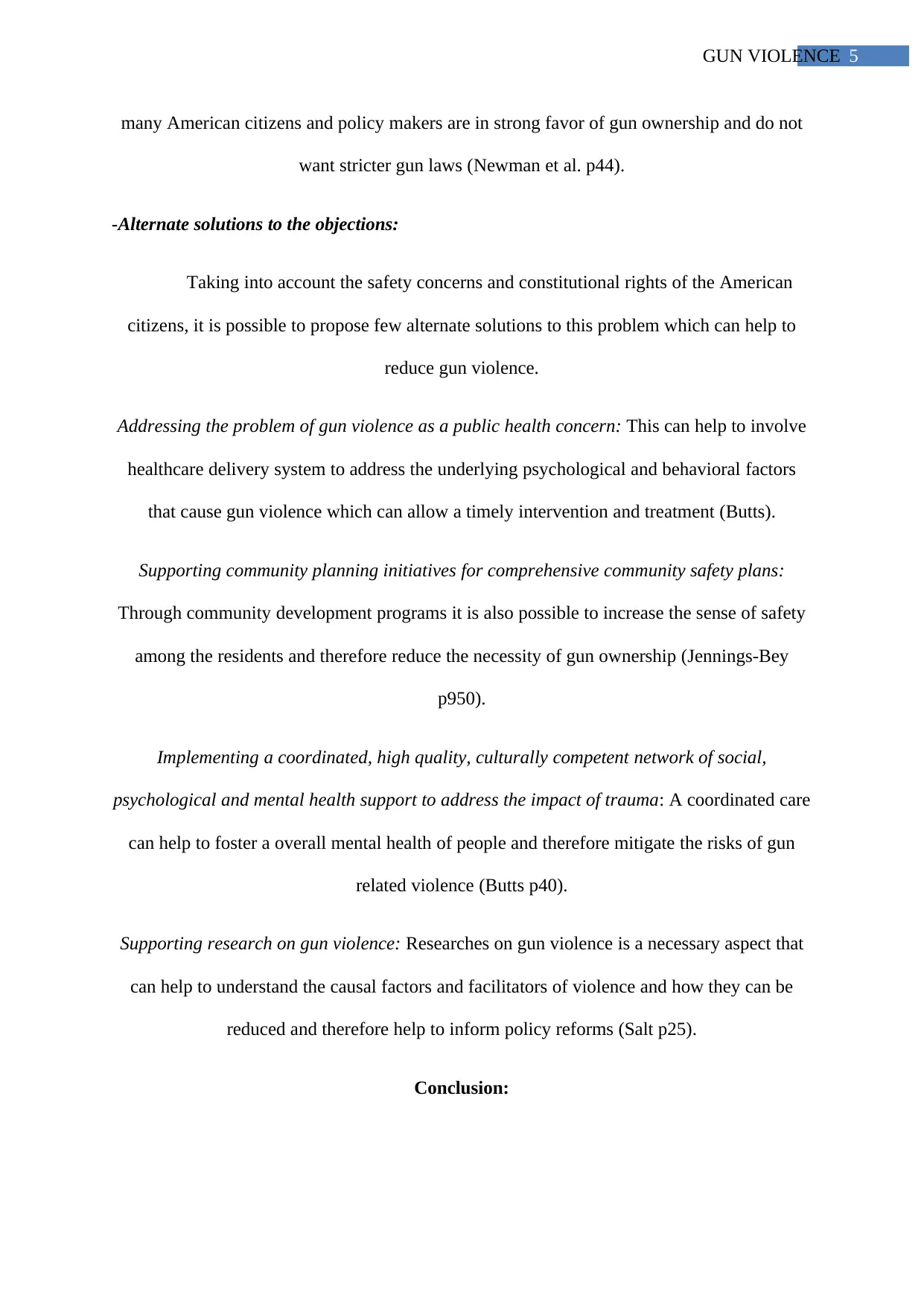
5GUN VIOLENCE
many American citizens and policy makers are in strong favor of gun ownership and do not
want stricter gun laws (Newman et al. p44).
-Alternate solutions to the objections:
Taking into account the safety concerns and constitutional rights of the American
citizens, it is possible to propose few alternate solutions to this problem which can help to
reduce gun violence.
Addressing the problem of gun violence as a public health concern: This can help to involve
healthcare delivery system to address the underlying psychological and behavioral factors
that cause gun violence which can allow a timely intervention and treatment (Butts).
Supporting community planning initiatives for comprehensive community safety plans:
Through community development programs it is also possible to increase the sense of safety
among the residents and therefore reduce the necessity of gun ownership (Jennings-Bey
p950).
Implementing a coordinated, high quality, culturally competent network of social,
psychological and mental health support to address the impact of trauma: A coordinated care
can help to foster a overall mental health of people and therefore mitigate the risks of gun
related violence (Butts p40).
Supporting research on gun violence: Researches on gun violence is a necessary aspect that
can help to understand the causal factors and facilitators of violence and how they can be
reduced and therefore help to inform policy reforms (Salt p25).
Conclusion:
many American citizens and policy makers are in strong favor of gun ownership and do not
want stricter gun laws (Newman et al. p44).
-Alternate solutions to the objections:
Taking into account the safety concerns and constitutional rights of the American
citizens, it is possible to propose few alternate solutions to this problem which can help to
reduce gun violence.
Addressing the problem of gun violence as a public health concern: This can help to involve
healthcare delivery system to address the underlying psychological and behavioral factors
that cause gun violence which can allow a timely intervention and treatment (Butts).
Supporting community planning initiatives for comprehensive community safety plans:
Through community development programs it is also possible to increase the sense of safety
among the residents and therefore reduce the necessity of gun ownership (Jennings-Bey
p950).
Implementing a coordinated, high quality, culturally competent network of social,
psychological and mental health support to address the impact of trauma: A coordinated care
can help to foster a overall mental health of people and therefore mitigate the risks of gun
related violence (Butts p40).
Supporting research on gun violence: Researches on gun violence is a necessary aspect that
can help to understand the causal factors and facilitators of violence and how they can be
reduced and therefore help to inform policy reforms (Salt p25).
Conclusion:
⊘ This is a preview!⊘
Do you want full access?
Subscribe today to unlock all pages.

Trusted by 1+ million students worldwide
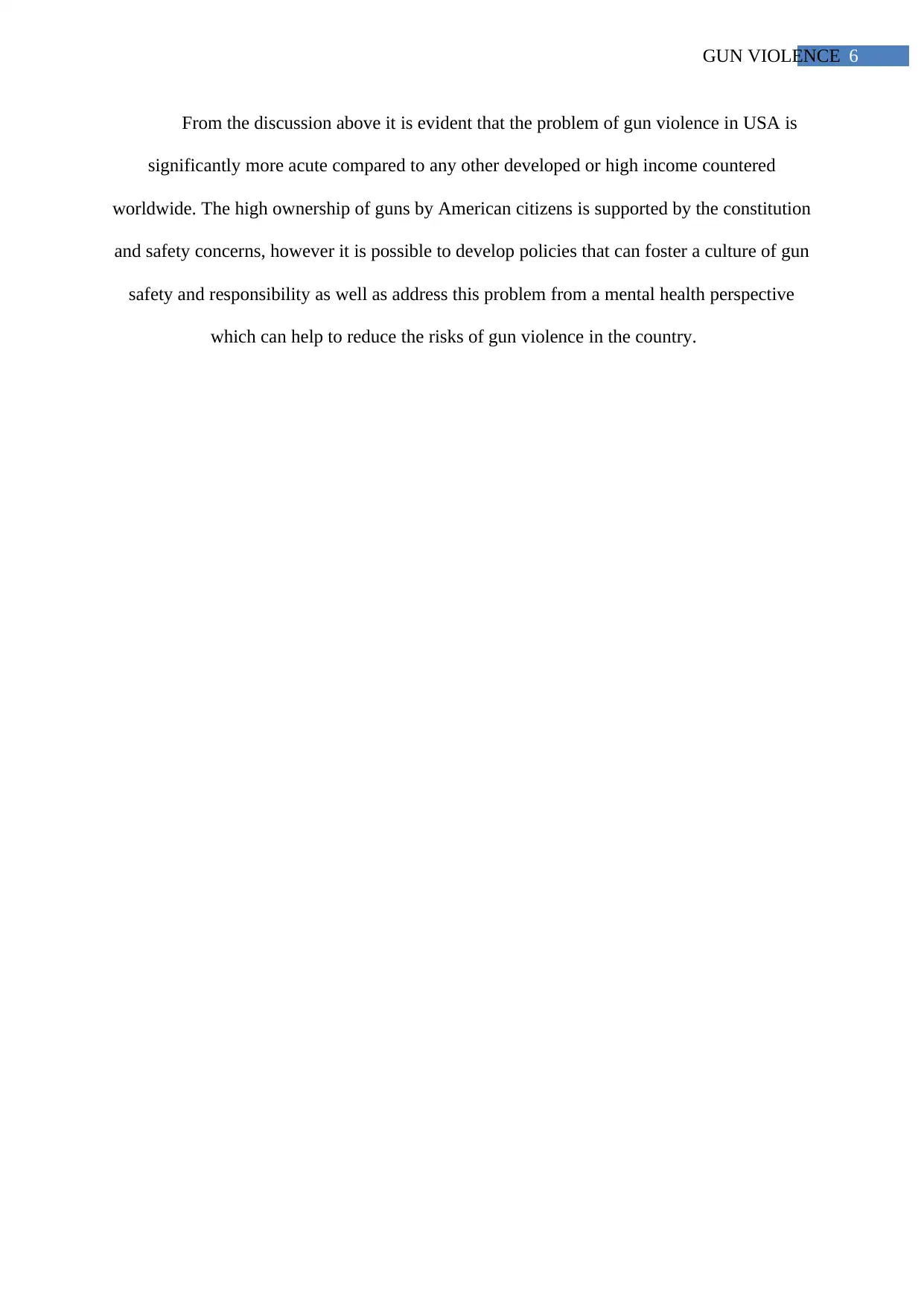
6GUN VIOLENCE
From the discussion above it is evident that the problem of gun violence in USA is
significantly more acute compared to any other developed or high income countered
worldwide. The high ownership of guns by American citizens is supported by the constitution
and safety concerns, however it is possible to develop policies that can foster a culture of gun
safety and responsibility as well as address this problem from a mental health perspective
which can help to reduce the risks of gun violence in the country.
From the discussion above it is evident that the problem of gun violence in USA is
significantly more acute compared to any other developed or high income countered
worldwide. The high ownership of guns by American citizens is supported by the constitution
and safety concerns, however it is possible to develop policies that can foster a culture of gun
safety and responsibility as well as address this problem from a mental health perspective
which can help to reduce the risks of gun violence in the country.
Paraphrase This Document
Need a fresh take? Get an instant paraphrase of this document with our AI Paraphraser
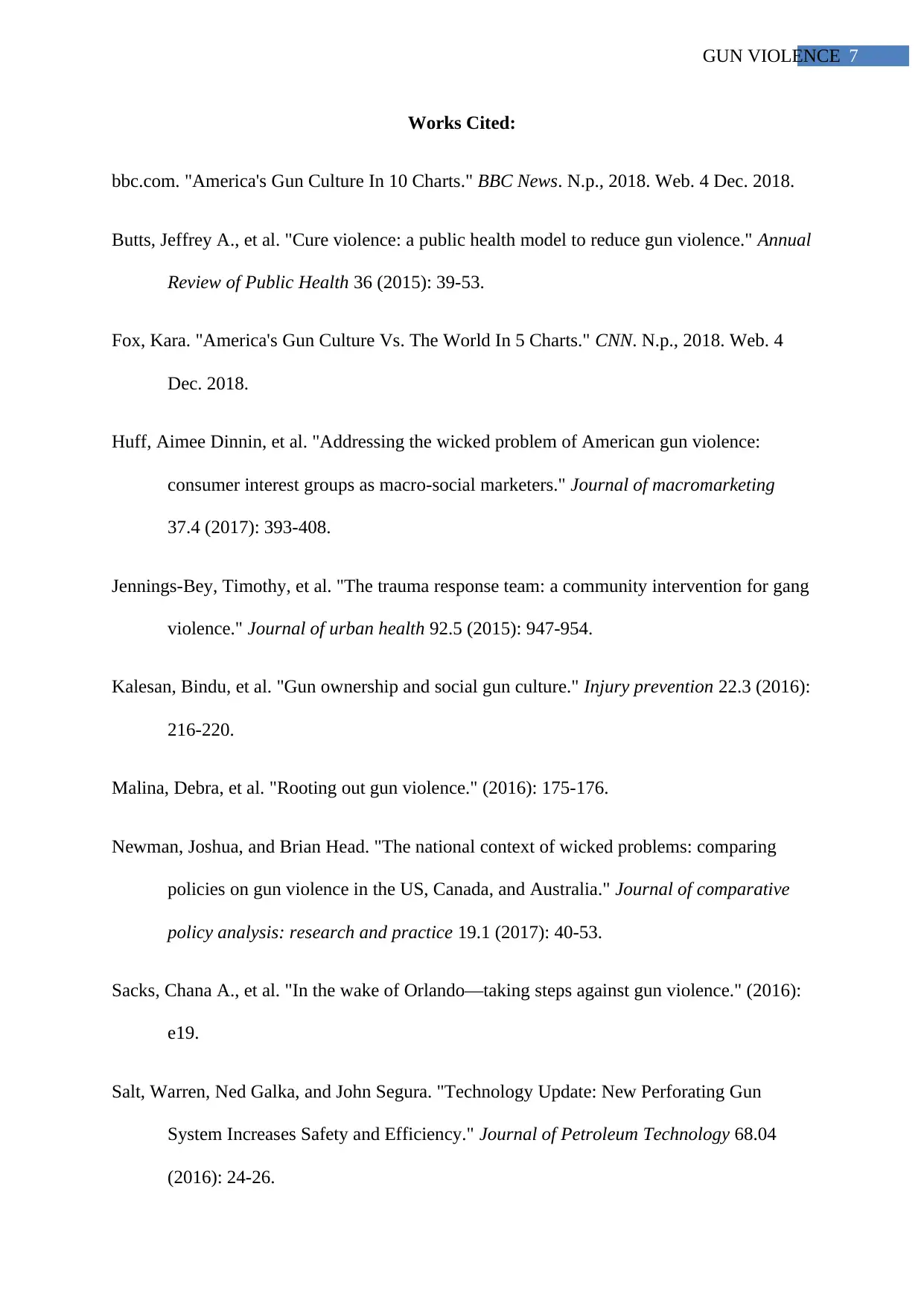
7GUN VIOLENCE
Works Cited:
bbc.com. "America's Gun Culture In 10 Charts." BBC News. N.p., 2018. Web. 4 Dec. 2018.
Butts, Jeffrey A., et al. "Cure violence: a public health model to reduce gun violence." Annual
Review of Public Health 36 (2015): 39-53.
Fox, Kara. "America's Gun Culture Vs. The World In 5 Charts." CNN. N.p., 2018. Web. 4
Dec. 2018.
Huff, Aimee Dinnin, et al. "Addressing the wicked problem of American gun violence:
consumer interest groups as macro-social marketers." Journal of macromarketing
37.4 (2017): 393-408.
Jennings-Bey, Timothy, et al. "The trauma response team: a community intervention for gang
violence." Journal of urban health 92.5 (2015): 947-954.
Kalesan, Bindu, et al. "Gun ownership and social gun culture." Injury prevention 22.3 (2016):
216-220.
Malina, Debra, et al. "Rooting out gun violence." (2016): 175-176.
Newman, Joshua, and Brian Head. "The national context of wicked problems: comparing
policies on gun violence in the US, Canada, and Australia." Journal of comparative
policy analysis: research and practice 19.1 (2017): 40-53.
Sacks, Chana A., et al. "In the wake of Orlando—taking steps against gun violence." (2016):
e19.
Salt, Warren, Ned Galka, and John Segura. "Technology Update: New Perforating Gun
System Increases Safety and Efficiency." Journal of Petroleum Technology 68.04
(2016): 24-26.
Works Cited:
bbc.com. "America's Gun Culture In 10 Charts." BBC News. N.p., 2018. Web. 4 Dec. 2018.
Butts, Jeffrey A., et al. "Cure violence: a public health model to reduce gun violence." Annual
Review of Public Health 36 (2015): 39-53.
Fox, Kara. "America's Gun Culture Vs. The World In 5 Charts." CNN. N.p., 2018. Web. 4
Dec. 2018.
Huff, Aimee Dinnin, et al. "Addressing the wicked problem of American gun violence:
consumer interest groups as macro-social marketers." Journal of macromarketing
37.4 (2017): 393-408.
Jennings-Bey, Timothy, et al. "The trauma response team: a community intervention for gang
violence." Journal of urban health 92.5 (2015): 947-954.
Kalesan, Bindu, et al. "Gun ownership and social gun culture." Injury prevention 22.3 (2016):
216-220.
Malina, Debra, et al. "Rooting out gun violence." (2016): 175-176.
Newman, Joshua, and Brian Head. "The national context of wicked problems: comparing
policies on gun violence in the US, Canada, and Australia." Journal of comparative
policy analysis: research and practice 19.1 (2017): 40-53.
Sacks, Chana A., et al. "In the wake of Orlando—taking steps against gun violence." (2016):
e19.
Salt, Warren, Ned Galka, and John Segura. "Technology Update: New Perforating Gun
System Increases Safety and Efficiency." Journal of Petroleum Technology 68.04
(2016): 24-26.

8GUN VIOLENCE
Stark, David E., and Nigam H. Shah. "Funding and publication of research on gun violence
and other leading causes of death." Jama 317.1 (2017): 84-85.
Swanson, Jeffrey W., et al. "Mental illness and reduction of gun violence and suicide:
bringing epidemiologic research to policy." Annals of epidemiology 25.5 (2015): 366-
376.
Stark, David E., and Nigam H. Shah. "Funding and publication of research on gun violence
and other leading causes of death." Jama 317.1 (2017): 84-85.
Swanson, Jeffrey W., et al. "Mental illness and reduction of gun violence and suicide:
bringing epidemiologic research to policy." Annals of epidemiology 25.5 (2015): 366-
376.
⊘ This is a preview!⊘
Do you want full access?
Subscribe today to unlock all pages.

Trusted by 1+ million students worldwide
1 out of 9
Related Documents
Your All-in-One AI-Powered Toolkit for Academic Success.
+13062052269
info@desklib.com
Available 24*7 on WhatsApp / Email
![[object Object]](/_next/static/media/star-bottom.7253800d.svg)
Unlock your academic potential
Copyright © 2020–2025 A2Z Services. All Rights Reserved. Developed and managed by ZUCOL.





